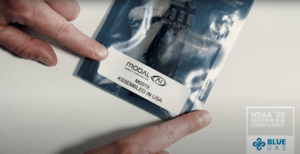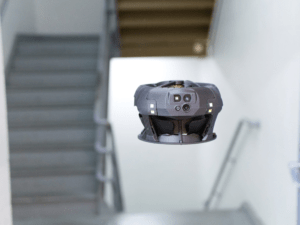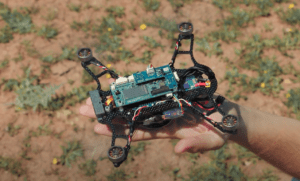



ModalAI, Inc. Blue UAS Framework autopilots are NDAA-compliant and assembled in the USA
ModalAI Supporting Bluer and Better UAS: the Blue sUAS Framework
By: Dawn Zoldi (Colonel, USAF Ret.)
Many assume the Defense Innovation Unit’s (DIU) Blue UAS program focuses solely on ready-to-fly drones. “Blue,” however, consists of several distinct, but related, lines of effort.
DroneLife · The – Blue – SUAS – Framework – A-Conversation – With – ModalAI
At its heart, the program exists to spur faster acquisitions of all the cyber-secure pieces and parts that enable uncrewed aircraft systems (UAS) operations for the Department of Defense (DOD) and its federal partners. Autopilot systems rank high among these required UAS critical components. And San Diego, California-based startup ModalAI’s VOXL® family of autopilots has formed the nucleus of the Blue UAS framework, almost since its inception.
Blue What?
As Section 848 of the Fiscal Year 2020 National Defense Authorization Act (FY20 NDAA) made its way through the halls of Congress (prohibiting DOD from operating or procuring UAS or related services and equipment from China) the Army had already short-listed 5 companies for its Short Range Reconnaissance built-to-mil-specifications UAS program. The DIU approached these companies and the General Services Agency to create a procurement mechanism for NDAA-compliant UAS solutions: the “Blue UAS Cleared UAS” (commonly known as Blue UAS). In 2022, Blue UAS evolved into Blue 2.0 to bring a wide variety of commercial (vice mil-spec) UAS into the fold.
Over time, DIU has created a whole host of Blue-related efforts. The Blue UAS On-Ramp streamlines the approvals and vetting to onboard commercial UAS into the government market. Its Blue UAS Hub website outlines both resources, process and requirements information. DIU uses the Commercial Solutions Opening process, which it calls the Blue UAS Foundry, to rapidly prototype and scale new or existing UAS through iterative experimentation.
The Blue UAS Framework actually preceded these other Blue UAS efforts. It focuses on best in class, secure supply chain, interoperable UAS components and software. This year, besides adding commercial UAS into the mix, DIU publicly launched the highly impactful Blue UAS Framework 2.0 effort.
ModalAI, and it’s VOXL products, have been the core autopilot for two generations of DIU’s Blue UAS Framework program. “The Blue UAS Framework program has driven the resurgence of domestic UAS capabilities. We are proud our advanced autopilots have been a part of this since the beginning,” said Chad Sweet, CEO and co-founder of ModalAI, Inc.


99 ModalAI VOXL m500 drones deployed as part of the Darpa OFFset program in 2021
VOXL Takes Flight
In 2018, several former Qualcomm Technologies, Inc. employees, with a passion for advancing the state of the art autopilots, kicked off ModalAI. Leveraging their prior research and development in the drone and robotic markets, the company’s founders set out to manufacture U.S.-made AI-powered and size, weight and power (SWAP)-optimized autopilots for UAS and robots utilizing aerial and ground autonomous navigation systems to communicate on 4G and 5G cellular networks.
Just four months after the company’s inception, the Army sought best-in-class integratable, open architecture and modular design software and hardware components for small UAS. The desired tech included, among other things, autopilot software and firmware. The Army selected VOXL.


Cleo Robotics’ Dronut
VOXL Flight marries the power of a Snapdragon SoC (system on a chip) with the flexibility and ease of a Pixhawk® flight controller. This combination enables much quicker time to market for obstacle avoidance and GPS-denied (indoor) navigation. The dense architecture eliminates the need for developers to use several computing components, which would traditionally add to the weight of their UAVs.
VOXL-powered drones can fly autonomously without WiFi or GPS, making them an appealing option for mission-critical applications. Boston-based Cleo Robotics uses the first generation VOXL to power the Dronut, a donut-shaped UAV with enclosed propellers that navigates autonomously in place of humans, in tight hazardous environments like in tunnels, around scaffolding and inside buildings.
Building on this initial success, the company launched VOXL 2 for Blue 2.0.


ModalAI’s VOXL 2 enables smaller, smarter and safer drones
VOXL 2 Still Blue
In April 2022, ModalAI announced its VOXL 2, a 5G-connected autopilot with more AI computing capability than any other similar product globally. DIU partially funded the development of VOXL 2 to advance domestic autopilot capabilities, as part of its Blue UAS Framework 2.0 iteration.
Weighing only 16 grams and powered by the Qualcomm® Flight RB5 5G platform, VOXL 2 integrates a PX4 real-time flight controller, a state-of-the-art CPU, video encoder, GPU and Neural Processing Unit (NPU), with ModalAI’s open VOXL SDK. The SDK comes complete with autonomous behaviors required to safely and reliably fly BVLOS and avoid obstacles. The included mapping and planning software provides a route for a given desired trajectory, mapping and navigating around obstacles to achieve the best path. Collision Prevention sets the parameter for minimum allowed approach distance. This tech supports robust support for 4G/5G-based beyond visual line of sight (BVLOS) flight.
“VOXL 2 creates a major leap in computing capability for the UAS industry,” noted Sweet. “From developing the first Blue UAS Framework autopilot, VOXL, to unlocking 5G skies with the Qualcomm Flight RB5 5G Platform, VOXL 2 is an important milestone to enable the next generation of smaller, smarter, and safer drones.”
Today, hundreds of government and commercial partners, developers and researchers across the globe are integrating VOXL 2 in their newest UAS and robot fleets. In 2021, for example, the Defense Advanced Research Projects Agency (DARPA) deployed 100s of VOXL-powered drones as part of its OFFensive Swarm-Enabled Tactics, or OFFSET, program. In the future, expect to see “bluer” skies with new drones powered by VOXL 2.
Read more about Blue sUAS and ModalAI:

 Dawn M.K. Zoldi (Colonel, USAF, Retired) is a licensed attorney with 28 years of combined active duty military and federal civil service to the U.S. Air Force. She is the CEO & Founder of P3 Tech Consulting and an internationally recognized expert on uncrewed aircraft system law and policy. Zoldi contributes to several magazines and hosts popular tech podcasts. Zoldi is also an Adjunct Professor for two universities, at the undergraduate and graduate levels. In 2022, she received the Airwards People’s Choice Industry Impactor Award, was recognized as one of the Top Women to Follow on LinkedIn and listed in the eVTOL Insights 2022 PowerBook. For more information, follow her on social media and visit her website at: https://www.p3techconsulting.com.
Dawn M.K. Zoldi (Colonel, USAF, Retired) is a licensed attorney with 28 years of combined active duty military and federal civil service to the U.S. Air Force. She is the CEO & Founder of P3 Tech Consulting and an internationally recognized expert on uncrewed aircraft system law and policy. Zoldi contributes to several magazines and hosts popular tech podcasts. Zoldi is also an Adjunct Professor for two universities, at the undergraduate and graduate levels. In 2022, she received the Airwards People’s Choice Industry Impactor Award, was recognized as one of the Top Women to Follow on LinkedIn and listed in the eVTOL Insights 2022 PowerBook. For more information, follow her on social media and visit her website at: https://www.p3techconsulting.com.
Miriam McNabb is the Editor-in-Chief of DRONELIFE and CEO of JobForDrones, a professional drone services marketplace, and a fascinated observer of the emerging drone industry and the regulatory environment for drones. Miriam has penned over 3,000 articles focused on the commercial drone space and is an international speaker and recognized figure in the industry. Miriam has a degree from the University of Chicago and over 20 years of experience in high tech sales and marketing for new technologies.
For drone industry consulting or writing, Email Miriam.
TWITTER:@spaldingbarker
Subscribe to DroneLife here.
See Also
Tags: Blue sUASBlue sUAS 2.0Blue sUAS frameworkdrone autopilotModalAI





Related Posts
Korean Air Showcases Advanced UAV Portfolio at Seoul ADEX 2025
Quantum Systems Acquires German AI Company Spleenlab
FAA Shutdown Stalls Drone Progress: Waivers, BVLOS Rulemaking, and Modernization Delayed